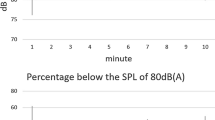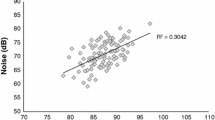Abstract
Nowadays, many occupations require a high vocal loading capacity. Therefore, it becomes increasingly important to have suitable test procedures for the vocal load, which can be executed with a low personnel and temporal expenditure. Patients with decreased vocal loading capacity were distinguished from test persons free of voice complaints with a 15-min test. It should be examined whether the test duration can be further shortened by an increase in the demanded vocal intensity. Sixty two persons underwent a vocal load test (VLT) of 10 min: in each case, 1 min in the volumes 75 dB(A) and 80 dB(A). Volume and fundamental frequency were measured real time. Before and directly after vocal load, as well as after a 30-min voice rest, the Goettingen hoarseness diagram was executed for the objective judgment of vocal quality. Besides, every person assessed himself on the bases of the Voice Handicap Index (VHI 12) and a questionnaire on the subjective state before the examination and after the VLT. The test could be mastered by all participants, patients and test persons, and was evaluated by all as tiring. However, we could not distinguish persons who indicated a decreased vocal maximum stress in everyday life from persons without vocal complaints using the shorter test with higher load, which was possible in the 15-min test pattern. A shortening of the test duration to 10 min for an examination of the vocal loading capacity is not possible, in spite of raised vocal load. It was proved in this study that a reliable distinction between patients and test persons was not possible using the 10-min vocal load test. A reliable statement concerning the permanent capacity of the voice cannot be made. Further scientific investigation in the important field of vocal load diagnostics is required.




Similar content being viewed by others
References
Dejonckere PH, Bradley P, Clemente P et al (2001) A basic protocol for functional assessment of voice pathology, especially for investigating the efficacy of (phonosurgical) treatments and evaluating new assessment techniques. Guideline elaborated by the Committee on Phoniatrics of the European Laryngological Society (ELS). Eur Arch Otorhinolaryngol 258:77–82
Buekers R, Bierens E, Kingma H, Marres EHMA (1995) Vocal load as measured by the voice accumulator. Folia Phoniat et Logop 47:252–261
Böhme G (Hrsg) (2003). Sprach-, Sprech-, Stimm- und Schluckstörungen. Bd. 1, Klinik. München, Jena: Elsevier, Urban und Fischer, p 154
Wendler J, Seidner W, Eysoldt U (2005) Lehrbuch der Phoniatrie und Pädaudiologie. Stuttgart, New York, p 141
Seidner W, Stürzebecher E, Wagner H (1981) Belastungsphonographie. Folia Phoniat 33:100–104
Seidner W (1985) Objektive Qualitätsbeurteilung der Stimme mittels Dynamikmessungen. Z Klin Med 40:1521–1525
Siegert C (1987) Recommendation for a standard tolerance test. Union of the European Phoniatricians. Ann Bull, pp 46-47
Siegert C, Baldauf J, Beyer B (1989) Über Erfahrungen mit der “Voxfunktionsmustermethode” in der phoniatrischen Praxis unter besonderer Berücksichtigung der Feinklassifizierung und Stimmbelastungstests. Sprache Stimme Gehör 13:1–4
Heinemann M (1972) Zur Frage der Stimmbelastungsfähigkeit vor einer Ausbildung in Sprechberufen. Zschr ärztl Fortbild 66:411–413
Brunner E, Friedrich G (1989) Zur Beurteilung von Stimmleistung und Sprechstimme in der phoniatrisch-logopädischen Praxis. Sprache Stimme Gehör 13:185–187
Nedlin K (2001) Neue Untersuchungen zur Beurteilung der stimmlichen Belastbarkeit–Entwicklung eines Stimmbelastungstests. Diss, Halle-Wittenberg
Hanschmann H, Wlodarz M, Berger R (2010) Standardised voice diagnostics—first experiences with a computer-aided voice strain test. Laryngo Rhino Otol 89(9):544–548
Fröhlich M, Michaelis D, Kruse E (1998) Objektive Beschreibung der Stimmgüte unter Verwendung des Heiserkeits-Diagramms. HNO 46:684–689
Michaelis D, Gramms T, Strube HW (1997) Glottal-to-noise excitation ratio—a new measure for describing pathological voices. Acustica 83:700–706
Jacobson BH, Johnson A, Grywalski C, Silbergleit A, Jacobson G, Benninger MS, Newman CW (1997) The Voice Handicap Index (VHI): development and validation. AM J Speech Lang Pathol 6:66–70
Nawka T, Wiesmann U, Gonnermann U (2003) Validation of the German version of the Voice Handicap Index. HNO 51:921–930
Kittel G, Moser M (1985) Vergleichende Untersuchungen bei Stimmeignungsprüfungen. Folia Phoniat 37:75–80
Conflict of interest
The authors declare that no conflict of interest exists according to the guidelines of the International Committee of Medical Journal Editors.
Author information
Authors and Affiliations
Corresponding author
Rights and permissions
About this article
Cite this article
Hanschmann, H., Gaipl, C. & Berger, R. Preliminary results of a computer-assisted vocal load test with 10-min test duration. Eur Arch Otorhinolaryngol 268, 309–313 (2011). https://doi.org/10.1007/s00405-010-1428-3
Received:
Accepted:
Published:
Issue Date:
DOI: https://doi.org/10.1007/s00405-010-1428-3




